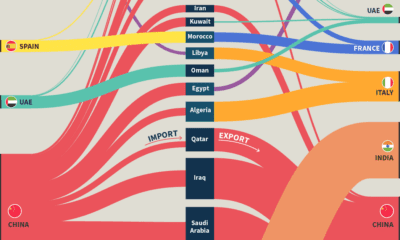Misc
Map Explainer: The Gaza Strip

Map Explainer: The Gaza Strip
Recent attacks on Israel by Hamas have placed the Gaza Strip firmly in the spotlight of the global news cycle.
While conflict in that part of the world is thoroughly covered in headlines and news stories, more basic facts about Gaza receive less attention. With this infographic, we aim to fill in some of those gaps, including demographics, infrastructure, and more.
Below, we outline three key facts to know about the Gaza Strip and the people who live there:
1. Gaza is Young and Increasingly Crowded
Gaza has a high fertility rate (3.9), and as a result, nearly half of the people living there are children. Much of this rapidly growing population lives in crowded cities and camps that are some of the most densely populated areas in the world.
The majority of people in the Gaza Strip are officially considered refugees by the UN. Over many decades, refugee camps have become permanent settlements, blending with the surrounding urban areas. Upwards of 80% of the population relies on international aid for basic services and sustenance.
In terms of religion, Gaza is very uniform. 99% of the population are Sunni Muslims. This is similar to Egypt and other North African nations.
2. The Territory is Tightly Controlled
Israel has enforced a land, air, and sea blockade since 2007, when Hamas took control of the Gaza Strip and Israel’s Security Cabinet labeled region a “hostile entity”. The land border of Gaza Strip is heavily fortified consisting of double-wired fencing and concrete barriers. These borders follow the “Green Line”, a demarcation set after the end of the Arab–Israeli War. There is also a 100-300 meter buffer zone inside the territory’s border where access is restricted.
There are two border crossings—one into Egypt in the south and one into Israel in the north—that a limited number of civilians can cross. Over the years, border crossings on the east side of the territory have been closed down. There is an additional large scale crossing on the bottom corner of the territory that serves as a checkpoint for goods entering from Egypt.
The region’s airspace is controlled by Israel. Even its electro-magnetic space is restricted, meaning many Palestinians rely on 2G and 3G.
3. Infrastructure is Patchy
Multiple years of conflict and underinvestment have left infrastructure in shambles in much of the Gaza Strip.
For example, there is a just single diesel power plant servicing the entire region. Power lines run into Gaza from neighboring Israel, but even in non-conflict periods, the region runs a large electricity deficit.
Gaza accesses fresh water via the Coastal Aquifer—an underground water supply that is dwindling due to over-extraction—and from desalination plants. International aid efforts are improving the situation, but infrastructure remains damaged by neglect and intermittent air strikes.
Water treatment infrastructure has slowly been improving due to foreign aid, and less raw sewage is now entering the Mediterranean Sea. This clean-up effort has helped create more recreation opportunities along the territory’s beaches.
United States
Charted: What Southeast Asia Thinks About China & the U.S.
A significant share of respondents from an ASEAN-focused survey are not happy about rising American and Chinese influence in the region.

What Southeast Asia Thinks About China & the U.S.
This was originally posted on our Voronoi app. Download the app for free on iOS or Android and discover incredible data-driven charts from a variety of trusted sources.
This chart visualizes the results of a 2024 survey conducted by the ASEAN Studies Centre at the ISEAS-Yusof Ishak Institute. Nearly 2,000 respondents were asked if they were worried or welcoming of rising Chinese and American geopolitical influence in their country.
The countries surveyed all belong to the Association of Southeast Asian Nations (ASEAN), a political and economic union of 10 states in Southeast Asia.
Feelings Towards China
On average, a significant share of respondents from all 10 countries are worried about rising influence from both the U.S. and China.
However, overall skepticism is higher for China, at 74% (versus 59% for U.S.).
| Country | Worried About Growing 🇨🇳 Influence | Welcome Growing 🇨🇳 Influence |
|---|---|---|
| 🇧🇳 Brunei | 58% | 42% |
| 🇰🇭 Cambodia | 66% | 34% |
| 🇮🇩 Indonesia | 57% | 43% |
| 🇱🇦 Laos | 68% | 32% |
| 🇲🇾 Malaysia | 56% | 44% |
| 🇲🇲 Myanmar | 95% | 5% |
| 🇵🇭 Philippines | 81% | 19% |
| 🇸🇬 Singapore | 74% | 26% |
| 🇹🇭 Thailand | 84% | 16% |
| 🇻🇳 Vietnam | 96% | 4% |
| Average | 74% | 27% |
The recently-cooled but still active territorial concerns over the South China Sea may play a significant role in these responses, especially in countries which are also claimants over the sea.
For example, in Vietnam over 95% of respondents said they were worried about China’s growing influence.
Feelings Towards America
Conversely, rising American influence is welcomed in two countries with competing claims in the South China Sea, the Philippines (69%) and Vietnam (55%).
| Country | Worried About Growing 🇺🇸 Influence | Welcome Growing 🇺🇸 Influence |
|---|---|---|
| 🇧🇳 Brunei | 73% | 27% |
| 🇰🇭 Cambodia | 58% | 42% |
| 🇮🇩 Indonesia | 73% | 27% |
| 🇱🇦 Laos | 79% | 21% |
| 🇲🇾 Malaysia | 68% | 32% |
| 🇲🇲 Myanmar | 45% | 55% |
| 🇵🇭 Philippines | 32% | 69% |
| 🇸🇬 Singapore | 37% | 63% |
| 🇹🇭 Thailand | 80% | 20% |
| 🇻🇳 Vietnam | 45% | 55% |
| Average | 59% | 41% |
Despite this, on a regional average, more respondents worry about growing American influence (59%) than they welcome it (41%).
Interestingly, it seems almost every ASEAN nation has a clear preference for one superpower over the other.
The only exception is Thailand, where those surveyed were not a fan of either option, with 84% worried about China, and 80% worried about the U.S.
-

 Culture6 days ago
Culture6 days agoThe World’s Top Media Franchises by All-Time Revenue
-

 Science2 weeks ago
Science2 weeks agoVisualizing the Average Lifespans of Mammals
-

 Brands2 weeks ago
Brands2 weeks agoHow Tech Logos Have Evolved Over Time
-

 Energy2 weeks ago
Energy2 weeks agoRanked: The Top 10 EV Battery Manufacturers in 2023
-

 Countries2 weeks ago
Countries2 weeks agoCountries With the Largest Happiness Gains Since 2010
-

 Economy2 weeks ago
Economy2 weeks agoVC+: Get Our Key Takeaways From the IMF’s World Economic Outlook
-

 Demographics1 week ago
Demographics1 week agoThe Countries That Have Become Sadder Since 2010
-

 Money1 week ago
Money1 week agoCharted: Who Has Savings in This Economy?

















